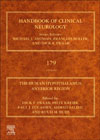
The Human Hypothalamus: Anterior Region
Swaab, Dick F.
Kreier, Felix
Lucassen, Paul J.
Salehi, Ahmad
Buijs, Ruud M.
The Hypothalamus is an important area of the brain for understanding a variety of neurological disorders. This volume summarizes for readers the anatomy and physiology of the anterior hypothalamus, to better understand pathology and treatment of hypothalamus related disorders. In addition to anatomy and physiology in humans, cytoarchitecture and chemoarchitecture in rodents is provided. The volume explores the role of the hypothalamus in disorders of eating, sleeping, anxiety, and mood, as well as its role in sexual behavior and gender identity. Coverage includes how Parkinson's, Alzheimer's and other neurological disorders relate to the hypothalamus. Reviews the anatomy and physiology of the anterior hypothalamusProvides cytoarchitecture and chemoarchitecture from rodentsDiscusses hypothalamic related disorders of eating, sleeping, anxiety, and moodCovers how Parkinson's, Alzheimer's and other neurological disorders relate to the hypothalamusExplores the role of the hypothalamus in sexual behavior and gender identity INDICE: Section 1: Introduction 1. History of neuroendocrinology/ hypothalamic research 2. Microscopic neuroanatomy of the hypothalamus, borders of nuclei, adult markers 3. MRI maps, segregation and white matter connectivity of the human hypothalamus in health 4. (G1) MRI of the hypothalamo-pituitary region 5. Neurogenesis in the adult hypothalamus 6. Generation of hypothalamic neurons from human pluripotent stem cells 7. Confounding factors for postmortemhypothalamic research: the art of matching Section 2: The hypothalamic cholinergic system 8. Functional changes in the cholinergic system in aging and AD, trophic factors 9. Neuropsychiatric symptoms of cholinergic deficiency occur with degradation of the projections from the nucleus basalis of Meynert 10. NBM degeneration predicts cognitive impairment in Parkinson's disease 11. Gene therapy for the NBM with NGF in Alzheimer 12. The Diagonal Band of Broca in health and disease 13. The effect of acetylcholine esterase inhibitors on the rate of NBM atrophy in Alzheimer's disease 14. Animal models for cholinergic system deficiency, including Down syndrome Section 3: The circadian- and circannual system: Suprachiasmatic nucleus (SCN) and Pineal Gland 15. Circadian clock gene mechanisms (in SCN, pineal gland and animal models): mutations and neuropsychiatric disorders 16. SCN functional neuroanatomy 17. Optic chiasm compression and disturbed temperature regulation 18. Development of the circadian system, relation to birth and neonatal intensive care unit 19. Alterations in the biological clock in adolescence and the emergence of neuropsychiatric disorders 20. Seasonal fluctuations in neuropsychiatric disorders (bulimia, schizophrenia, psychosis, aggression, suicide, narcolepsy in China) 21. Diurnal and seasonal rhythms in the human brain and their relation to AD 22. Circadian disruptions as a health risk: jet lag, shift work, etc. 23. Circadian changes in Alzheimer's disease: neurobiology, clinical problems and therapeutic opportunities 24. The Circadian System in Parkinson Disease, Multiple System Atrophy, and Progressive Supranuclear Palsy 25. Retina and melanopsin neurons (chemoarchitecture, changes in eye diseases and Alzheimer/ other neurodegenerative disorders) 26. Melanopsin-mediated papillary response to determine the integrity of the retino-hypothalamic tract 27. Pineal gland: melatonin in relation to puberty, sex, sleep, aging, Alzheimer, calcification 28. Melatonin receptors, agonist brain functions and therapies 29. Chronotherapy in epilepsy Section 4: Bed nucleus of the Stria Terminalis (BNST) and the Islands of Calleja (Insulae Terminalis) 30. Functional neuroanatomy of BNST neurocircuitry (DTI and rs-fMRI) 31. BNST activation during threat anticipation in generalized anxiety disorder, panic disorder and PTSD 32. DBS of the BNST for treatment resistant OCD, major depression and anorexia nervosa Section 5: Preoptic area. The sexually dimorphic nuclei of the anterior hypothalamus: Interstitial nucleus of the anterior hypothalamus (INAH-1) (= Sexually dimorphic nucleus of the preoptic area = intermediate nucleus = preoptic nucleus) and INAH2, 3 (= Uncinate nucleus) 33. INAH1: Cytoarchitecture, chemoarchitecture: relation to sleep and Alzheimer 34. INAH)-2 and -3: relation to development, gender and the mosaic concept 35. Hypothalamic preoptic causes of disturbed thermoregulation Section 6: Zona incerta (ZI) 36. Cytoarchitecture, chemoarchitecture 37. DBS of zona incerta for Parkinson Section 7A-7C: Supraoptic- and paraventricular nucleus (SON, PVN) and periventricular area Section 7A Vasopression and oxytocin 38. Vasopression and oxytocin extra-hypothalamic fibers and receptors in the human brain 39. Functional neuroanatomy of SON and PVN, social relationships and fMRI 40. The supraoptic and paraventricular nuclei in aging and neurodegenerative disorders 41. Oxytocin, eating behavior and metabolism in human 42. Vasopressin / Oxytocin deficient rodent models and diabetes insipidus/ obesity 43. Oxytocin for the treatment of drug and alcohol abuse 44. Oxytocin, vasopressin and cortisol changes in response to ecstasy consumption: clinical implications Section 7B Corticotrophin releasing hormone (CRH) 45. CRH and the timing of birth in humans 46. Prenatal stress, epigenetics, altered postnatal HPA-axis activity and outcome 47. The hyopthalamo-pituitary axis and auto-antibody related changes in hormones and (non)aggressive behavior 48. Animal models hypothalamo-pituitary-adrenal system, e.g. stress and depression Section 7C Thyrotropin releasing hormone (TRH) 49. Mutations causing central hypothyroidism 50. The hypothalamus in anxiety disorders (HPT-axis, HPA-axis)
- ISBN: 978-0-12-819975-6
- Editorial: Elsevier
- Encuadernacion: Cartoné
- Páginas: 807
- Fecha Publicación: 01/08/2021
- Nº Volúmenes: 1
- Idioma: Inglés
